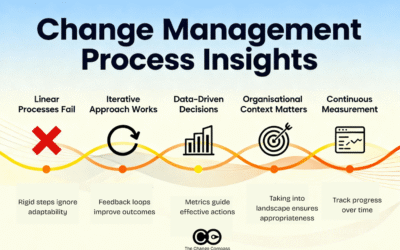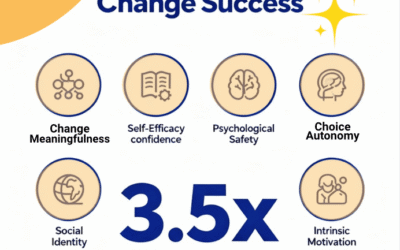There's a moment in Wicked the Movie when the main character Elphaba stands on the ramparts of Shiz University, green skin and all, and realises that the world has been lying to her. Glinda, her unlikely friend and mirror image, is learning something different: that...
Latest Blogs •
The Modern Change Management Process: Beyond Linear Steps to Data-Driven, Adaptive Transformation
The traditional image of change management involves a straightforward sequence: assess readiness, develop a communication plan, deliver training, monitor adoption, and declare success. Clean, predictable, linear. But this image bears almost no resemblance to how...
The Science of Change Success: What Research Shows About Predicting Change Adoption
Latest findings from academic studies reveal the real drivers behind successful organisational transformation If you're leading organisational change, you've probably wondered why some change initiatives take off while others crash and burn despite having similar...
Landing change effectively within a complex environment
Adapting to complex organizational change has always been a formidable challenge for organizations, but the complexities of today’s business landscape have taken this challenge to a new level. With the relentless march of various types of organizational change such as...
Understanding the Myth of Failing Fast
Central to many contemporary approaches to agile change management models is the concept of “failing fast.” This idea, popularized by agile methodology, suggests that failure is not only acceptable but desirable, as it provides valuable insights that can inform...
Rethinking Change Management – The “Light at the End of the Tunnel” Analogy
When navigating the complexities of organizational change, leaders often rely on analogies to communicate the journey and keep their teams motivated. One common analogy used in traditional change management is the “light at the end of the tunnel,” which portrays the...
How to use gamification for change: Your guide
Gamification is the application of game mechanics and elements to non-game activities, greatly enhancing the player experience. Whilst gamification has been around for a long time, it is only recently that it has been formalised as a structured method to achieve...
Oversight of Change Initiatives: Strategies for Successful Change
There is now plenty of research and articles on successful organizational change management out there. However, most of these are focused on driving a singular change process impacting a set of key stakeholders with one change management plan. The single change may be...
Why We Are Change Resistant: Insights and Solutions
Change is an inevitable part of, not just corporate life and business processes, but life in general. It’s a natural occurrence that we all must face at some point. But despite the many benefits that organizational change can bring, many of us are still reluctant to...
The Enterprise Change Champion Model: How to Build Change Capability and Talent – Simultaneously
Rethinking Change Champions Beyond the Project Lens For decades, the change champion has been a familiar figure in large-scale transformation projects – the trusted liaison between the change team and the business, responsible for rallying colleagues,...
Most change strategies are tactics. Here’s how to do it better.
Creating a strategic approach to effective communication and a change management plan and change management strategy in change management is one of the most important pieces of work for the change management practitioner. Done well, proactive change management...
Change Readiness Assessment: A Strategic Approach
Change readiness is one of the most critical, yet often misunderstood, concepts in organizational change management. For many practitioners, it’s been reduced to a series of surveys or assessments — a simple gauge of how “ready” stakeholders feel. But this...











